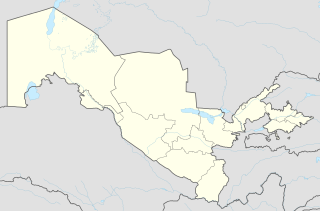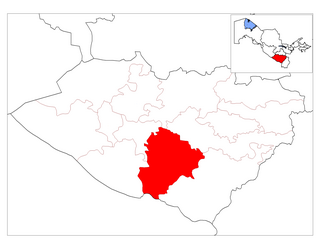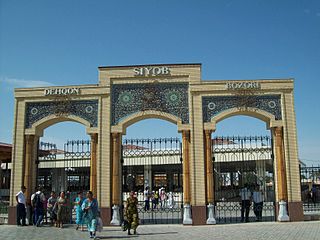This page is based on this
Wikipedia article Text is available under the
CC BY-SA 4.0 license; additional terms may apply.
Images, videos and audio are available under their respective licenses.

Uzbekistan is the common English name for the Uzbek Soviet Socialist Republic and later, the Republic of Uzbekistan, that refers to the period of Uzbekistan from 1924 to 1991. as one of the constituent republics of the Soviet Union. It was governed by the Uzbek branch of the Soviet Communist Party, the only legal political party, from 1925 until 1990. From 1990 to 1991, it was a sovereign part of the Soviet Union with its own legislation. Sometimes, that period is also referred to as Soviet Uzbekistan.

European route E 60 is the second longest E-road running from Brest, France, to Irkeshtam, Kyrgyzstan.

Jizzakh is a city and the center of Jizzakh Region in Uzbekistan, northeast of Samarkand. The population of Jizzakh on April 24, 2014, was approximately 324,136.

Qashqadaryo Region is one of the regions of Uzbekistan, located in the south-eastern part of the country in the basin of the Qashqadaryo River and on the western slopes of the Pamir-Alay mountains. It borders with Tajikistan, Turkmenistan, Samarqand Region, Bukhara Region and Surxondaryo Region. It covers an area of 28,400 km². The population is estimated to be around 2,067,000 (2007), with some 73% living in rural areas.

Samarqand Region is one of the regions of Uzbekistan. It is located in the center of the country in the basin of Zarafshan River. It borders with Tajikistan, Navoiy Region, Jizzakh Region and Qashqadaryo Region. It covers an area of 16,773 km². The population is estimated to be around 3,651,700, with some 75% living in rural areas.
Uzbekistan is a country with potential for an expanded tourism industry. Many of its Central Asian cities were main points of trade on the Silk Road, linking Eastern and Western civilizations. Today the museums of Uzbekistan store over two million artifacts, evidence of the unique historical, cultural and spiritual life of the Central Asian peoples that have lived in the region. Uzbekistan attracts tourists with its historical, archeological, architectural and natural treasures.

Uzbek cuisine shares the culinary traditions of Turkic peoples across Central Asia. There is a great deal of grain farming in Uzbekistan, so breads and noodles are of importance, and Uzbek cuisine has been characterized as "noodle-rich". Mutton is a popular variety of meat due to the abundance of sheep in the country and it is a part of various Uzbek dishes.

FC Shurtan Guzar is an Uzbek football club based in G‘uzor, Uzbekistan.

Boysun is a town in Surxondaryo Region, Uzbekistan and capital of Boysun District. The population as of the 1989 census was 16,700; an estimate for 2012 puts the population at 26,309.

The Samarkand Oblast was an oblast (province) of the Russian Empire between 1868 and 1924. It roughly corresponded to most of present-day central Uzbekistan and northwestern Tajikistan. It was created out of the northeastern part of Emirate of Bukhara. It consisted of the uyezds of Samarkand, Dzhizak, Katta-Kurgan and Khodzhent.

After the Uzbeks were driven out of Samarkand in early 1501 C.E., they regrouped in Bukhara. Muhammad Shaybani began to prepare for another attempt to take Samarkand in April - May 1501 C.E. Babur, the Timurid leader, decided to meet this threat before it arrived at the city. The two armies met at Sar-e-Pul, where a decisive battle was fought which decided the fate of the Timurids and of the region, resulting in gradual conquest of Transoxiana, Khwarezm and Khorasan by the Uzbeks.

Guzar District is a district of Qashqadaryo Region in Uzbekistan. The capital lies at G‘uzor.

Siyob Bazaar, also called Siab Bazaar, is the largest bazaar in Samarkand, Uzbekistan. All daily necessities, such as "Samarkand naan", are sold.
Asian Highway 63 (AH63) is a road in the Asian Highway Network running 2500 km from Samara, Russia to G‘uzor, Uzbekistan connecting AH6 to AH62.
The route is also numbered European route E121 and European route E40.

Afrasiab Museum of Samarkand is a museum located at the historical site of Afrasiyab, one of the largest archaeological sites in the world and the ancient city that was destroyed by the Mongols in the early 13th century. Museum building and the archaeological site are located in the north-eastern part of the city of Samarkand in the Central Asian country of Uzbekistan. It bears the name of Afrasiab, mythical king and hero of Turan. Permanent exhibition of the Afrasiab Museum of Samarkand is focused on the history of the city itself as well as the surrounding region. The museum building was designed by Armenian architect Bagdasarov Arzumanyan in 1970, at the time when Uzbek Soviet Socialist Republic was still part of the Soviet Union. The opening of the museum was dedicated to the 2500th anniversary of the founding of the city of Samarkand. Thematically, the museum is divided into five rooms dedicated to different periods of life in the fort of Afrasiyab.

















